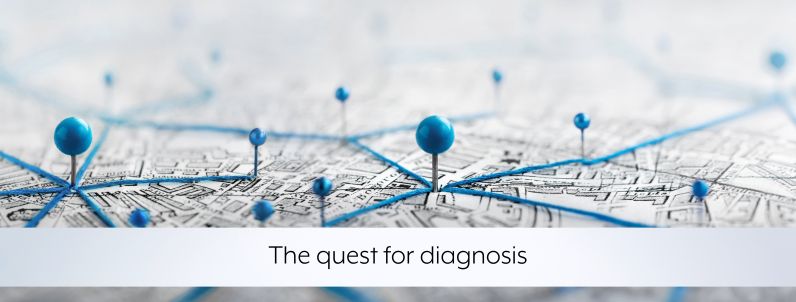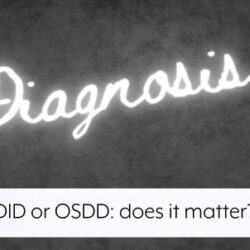
A personal journey to diagnosis and treatment with the Clinic for Dissociative Studies
I wanted to call this article ‘You have to kiss a lot of frogs before you find a therapist’, but that didn’t really seem fair on the many supportive therapists who have shared our journey to a diagnosis of dissociative identity disorder (DID). What I wanted to show, however, was the lengths it can take to establish the right diagnosis and the best therapist for the individual concerned. The fact that the two may be neither related nor sequential does not make the process easier. In fact, finding a diagnosis and a therapist can be rather like the age-old conundrum of the chicken and the egg: without a diagnosis, it can be hard to find a well-resourced therapist, yet without therapy it can be difficult for the client to understand themselves sufficiently to verbalise their experiences and obtain the correct, and therefore most helpful, diagnosis. If, along the way, misdiagnoses are made, unhelpful medications are issued and misunderstandings are ignored, the journey can be long, tiring and often weighted with a huge sense of futility. This was certainly our experience, but thankfully for us, the eventual presence of a DID-aware therapist and considerate GP meant that we were supported to pursue diagnosis and treatment through the London-based Clinic for Dissociative Studies.
I received the official diagnosis of dissociative identity disorder from the Clinic for Dissociative Studies in April 2015. I wasn’t surprised, but it still felt like a big deal. To finally have an acknowledged explanation of my experiences was literally life-shaking and for a while it took a lot of energy and support to keep myself grounded. I don’t doubt that I am not alone in this: indeed, the Clinic qualified my dissociative reaction as confirmation of the diagnosis and took care to keep communication lines open should I, or any of our identities, need them. I don’t deny that it was a difficult time for us. That said, I could understand the impact of no longer being able to deny my situation and its origins, but there seemed to be more going on than just that. It felt momentous and, a year on, I can see that it had a lot to do with the search for meaning, the resolution of the quest for diagnosis and, ultimately, a new beginning.
Looking back, I realise that I had spent over half my life looking for validation and understanding of a condition that felt confusing, tiring and shameful. Like a chef experimenting with different seasoning, I tried as many options as I could to achieve the right blend of therapy and medication to make my life taste right. But nothing seemed to fit. From taking beta-blockers for anxiety at seventeen, I spent the next 21 years mentally and physically off balance. My teens had been filled with repeated tests for glandular fever, which always came back negative, and by the time I reached university I had nothing but the rather unhelpful suggestion of post-viral fatigue syndrome to make sense of a range of symptoms, including anxiety, fatigue and muscle pain. I tried counselling at university and progressed to Prozac to counter depression. The problem was I wasn’t entirely sure why I was depressed. Something was clearly, deeply wrong, but if I couldn’t understand it how was I supposed to communicate it to someone else? I think it is true to say that I spent the majority of counselling sessions wishing that the counsellor was telepathic. I think I often still do.
Over the years the NHS provided medication, counselling, CBT and an appointment with a clinical psychologist who didn’t feel he needed to help. I had three significant breakdowns, chronic eczema and, ironically, glandular fever. Desperate for change, and all too aware of NHS limitations, I tried a variety of private counselling, NLP-based therapy, craniosacral therapy and The Journey® work. Most of these provided support and some helped action change, but none really got to the root of the matter and a couple were considerably destabilising. Yet throughout all this I managed to remain highly functional, completing my PhD and embarking on a career in writing and tuition. Other than to close friends, it was not apparent that life was becoming more and more difficult. However, by 2010 hidden memories had begun to surface and I returned to the GP, anxious for answers. She referred me for Dynamic Psychotherapy and after three assessments over as many months I was approved for their programme. All I had to do was wait two years.Unfortunately, DID doesn’t have a hold button and those two years became fraught with difficulty and increased multiplicity. Running out of options, my GP referred me to be assessed for borderline personality disorder. Luckily, the psychiatrist I saw was not willing to apply that label. Unfortunately, that left me no further forward. Since I was unable to do both, I turned down the offer of group art therapy at the Personality Disorder Clinic in order to wait for the psychodynamic therapy to become available. In the meantime, through academic research and the PODS website, Google provided me with the potential explanation of DID: something I viewed with initial cynicism and distrust in terms of it possibly relating to me.
With the feeling of very much having all my eggs in one basket, I was determined that psychodynamic therapy would be the answer. A long-term talking treatment, it works for many people, including those with DID. Our personalities were becoming more and more intrusive on daily life and, after almost six months, I revealed the situation to my therapist. I was met with misunderstanding and the response that ‘many therapeutic professionals don’t believe in this condition’. Disheartened, I withdrew and the weekly sessions became a case of saying what I felt he wanted to hear, whilst at home I struggled with the reality of living with multiple identities.
When I felt able to express my concerns that I wasn’t engaging with the therapy, I was discharged from the psychodynamic clinic. Through sheer good fortune I had met a writing colleague who was also a psychotherapist. After a couple of candid conversations with her, she offered to support me and my growing family of personalities. She had already worked with DID and was able to help more of us become present in therapy. I finally started to see the reality of my condition and its implications on my past, present and future.
This relationship worked well despite the limitations of expense and, more significantly, our sessions being conducted over Skype since she lives in France. Eventually, I hit an inevitable crisis point and it became clear that I needed more support. The experience of NHS crisis care, or Single Point of Access as it calls itself, was not one that lent itself well to DID, though not necessarily through any fault of its own. As I was to be told later by my local psychiatrist, and also to sadly experience, ‘There isn’t much point going to A&E in a crisis because they won’t know what to do with you’. In this instance I was sent home with instructions to take the sleeping medication I already had prescribed and to ‘try and get some rest’. A week or so of home visits from the Community Care Team’s collection of psychiatric nurses and occupational therapists just proved exhausting and frustrating: when someone new is introduced, however trustworthy, all our defences go down and we present as normal and capable. Not surprisingly we were not seen as having any need for support.
The couple of CCT members who did try to interact with us as more than just one personality were sensitive and understanding—sadly, there was no way of requesting their presence and I was pushed to be discharged. It was becoming increasingly clear that I needed a resource and treatment plan that did know what to do with me. After doing her own research, my therapist passed on the details of the Clinic for Dissociative Studies (CDS). Oh the awe and excitement of a specialist team who would not only assess me but also, hopefully, be able to offer a treatment programme. My GP also jumped at the chance to take this further and was quick to make a referral. Although her support has been unfailing, respectful and concerned, it was clear that she could also do with extra guidance.
The Clinic for Dissociative Studies offer a full and comprehensive diagnostic assessment but the funding for this has to be granted by your local commissioning group, with supporting evidence from your GP, therapist and/or psychiatrist. Obviously this meant more waiting, but once I had spoken at relative length with the Consultant Psychotherapist at the Clinic I was confident to leave it in their capable hands, being kept updated as the process continued.
Five months later I received the date to go to the Clinic. Sensibly I now realise, a friend offered to drive me down to London and generally pick up the pieces afterwards. It was a long afternoon. The first hour or so was spent with a senior psychotherapist in order for them to complete the DSM diagnostic questionnaire for dissociation and DID. It was quickly pointed out that we didn’t have to answer all 82 questions and that some of them would answer themselves as the interview progressed. The therapist conducting the interview was quick to put us at ease and to stress that none of it should be upsetting or triggering. Indeed, throughout our verbal and electronic correspondence with the Clinic, our multiplicity is always accepted and embraced. Emails come addressed to us all or, if they have been made with a specific part, will be addressed to them and usually refer to the others too. There is not an expectation that they will always speak to a ‘main’ alter and since having a dominant or lead part is no longer the case for us, we find it a great comfort.
Following the DSM assessment, we had almost two hours of psychotherapy assessment with one of their consultant psychotherapists. Naively, it hadn’t occurred to me that I would have to unpack the past, but obviously this is what would assist in cementing the diagnosis and ultimately achieving the funding for treatment. As with so many pleas for financial support, the more strongly they can be made, the better. Most people find this part of the assessment a taxing process but the sensitivity of the situation is well known to the assessor and you are treated with respect, care and consideration. Unfortunately, our experience was more intense than most since we hadn’t shared between ourselves much of the information that we needed to disclose. Our part Alfie (9) rescued me from my discomfort and mentioned sufficient for our assessor to have a clear background to our trauma. Whilst this was positive and useful, once we returned home the new revelations sent me into shock, Alfie into hiding and the others were left to pick up the pieces of our perceived self-betrayal. Ten months later, Alfie and I are finally beginning to speak again and I am grateful to the rest of us and our real life friends who have helped us keep going. I would like to reiterate that the assessment does not usually create such a response. That said, it would be sensible for anyone pursuing diagnosis with the Clinic to consider some coping strategies to keep you grounded and supported after the assessment.
After the assessment, the Clinic have the admirable task of compiling the information into a report to submit your local funding board. They offer their diagnosis with evidence to support and make the case for long-term psychotherapeutic treatment with a member of their specialist team. They also endeavour to show that the patient has been down all other available treatment routes in order to assert that this is the best and most cost effective option for them (compared say to long-term inpatient care). You are offered the opportunity to read the assessment report before it is sent, or any time afterwards (we didn’t feel reading it would be helpful at the time, but are beginning to consider reading it during one of our therapy sessions with the support of our therapist). The Clinic were keen to keep us in the loop with the process so we didn’t feel quite so cut adrift from what was being discussed about us.
Waiting for an answer from the funding board was perhaps the hardest part – so near and yet so far. The commissioners only fund one year at a time, so the Clinic makes repeat requests as your treatment continues. This, I am told, is relatively simple but you can choose not to be involved with this, although, once again, you will be kept up-to-date with what is happening. Within a couple of weeks of having funding accepted, the Clinic moved swiftly to place us with the most appropriate therapist in order to maximise a productive relationship. This is taken very seriously by the Clinic and it was suggested we considered the dynamic between the therapist and as many of us as possible at the introductory meeting. With our assessor’s support, we were encouraged to find a therapist who was a good enough fit for our needs. For us, the third time was a charm, and we are immensely grateful to have been given the opportunity of choice and not, as in other therapy situations, been forced to remain in an uncomfortable alliance.
Overall, from referral to therapy has taken around 12 months. In the scheme of my journey to therapy so far, that seems pretty bearable. My therapist comes from London to meet in a local volunteer centre near where I live and we have a double session of therapy (100 minutes) together each week. We also have the opportunity to contact her via text or email during the week for additional support and, on occasions of necessity, can even speak to her mid-week. It is important to mention that this care package is specific to our needs and our therapist’s availability, so may well be different for different patients—but this individual service is, I believe, one of the Clinic’s greatest assets. The strength of this support is invaluable in setting up a firm foundation from which to begin to deal with the underlying issues of our DID. My therapist is well-experienced both generally and with DID, and has ongoing supervision from the Clinic to support her. The Clinic also has psychiatric consultants with DID specialism, who may be part of the assessment process. It was a great help for us to see her compared to our local psychiatrist who kindly but dismissively told me he had no idea how to help.
Through embarking on therapy with the Clinic and knowing they are there for support, the day-to-day existence of living with DID is becoming easier. I am learning to accept myself, or rather ourselves, for what we are and I’m even beginning to look with less distrust at where it has all come from. Life will still have many challenges ahead of us, but I finally feel we are on the right path to reach our intended goal of being able to work as a team without distress or disharmony being generated from past pain. For us, DID is part of our daily life and we share it with many of those who are close to us. We find it easier that way, but understand it’s not the case for everyone. Admitting it to people makes it increasingly hard for us to pretend it’s not happening and, after 21 years and the advent of a clear diagnosis, that has to be a good thing.
Route to CDS diagnosis and treatment
| Step 1 | Referral to the Clinic from GP/therapist/psychiatrist |
| Step 2 | Clinic application for funding to the local NHS Clinical Commissiong Group (CCG) panel for diagnostic assessment |
| Step 3 | Clinic half-day diagnostic assessment of DSM interview and psychotherapy session. (May also include psychiatric assessment.) |
| Step 4 | Clinic write a diagnostic report and, if appropriate for treatment, send this and funding application to local NHS CCG for approval. |
| Step 5 | NHS CCG approval allows therapy to commence (usually one double face-to-face session a week with a main therapist and one session spread across the week on email/text/phone with a support therapist). |
| Step 6 | Clinic renew funding application as required (usually up to 5 years, due to the complexity of the condition), as well as being available for any concerns or questions during your therapy. |
About The Clinic for Dissociative Studies
Established in 1998, the Clinic for Dissociative Studies is an Independent Provider for the NHS of diagnosis, care and treatment for those with dissociative disorders. One of the few national centres dedicated to dissociation, it provides clinical supervision and training, as well as supporting and delivering research within the UK and internationally. The Clinic is staffed by ‘experienced senior psychotherapists with specialist experience in working with dissociative disorders’. They do not have set beliefs on whether an individual’s outcome should be ‘integration’ or ‘co-existence’ but serve to help each individual adapt to their condition and the way they live with it.
They operate primarily through NHS referral (GP or psychiatrist) and funding must be authorised from the local NHS Clinical Commissioners Group panel on each patient’s behalf. The assessment process is thorough and, although relatively intense, is dealt with sensitively by those who believe in the existence of such disorders. A comprehensive diagnostic report is put together which may recommend a treatment package with the Clinic and be used to seek funding for the Clinic’s services.
Information taken from www.clinicds.co.uk.


